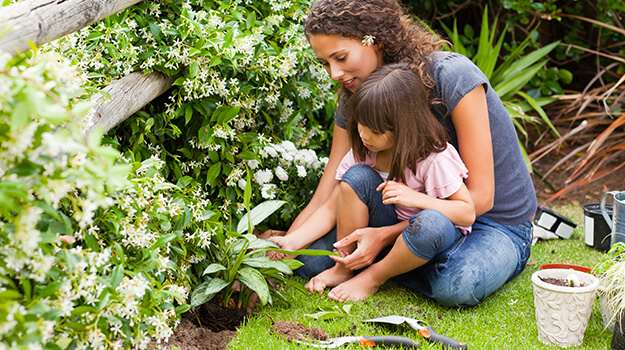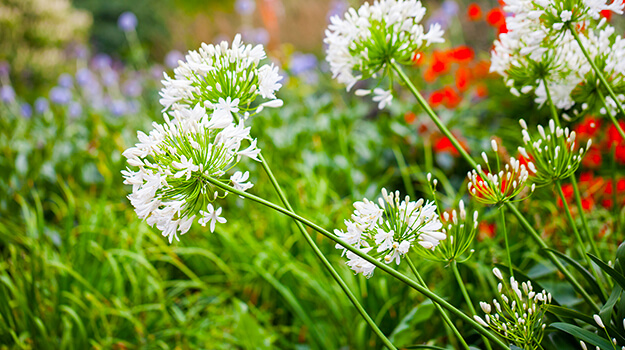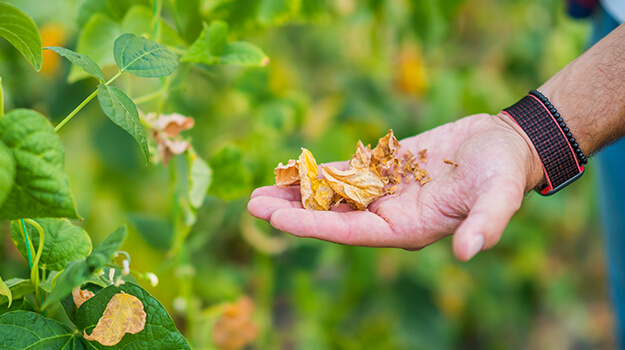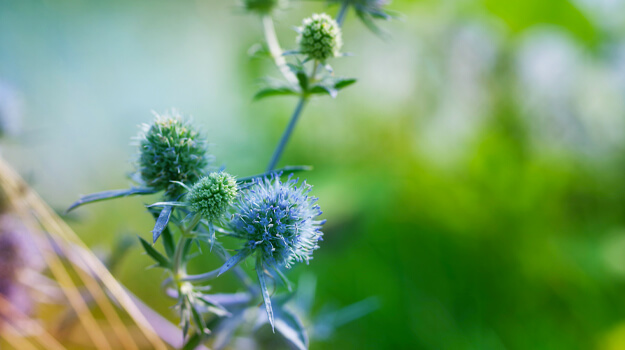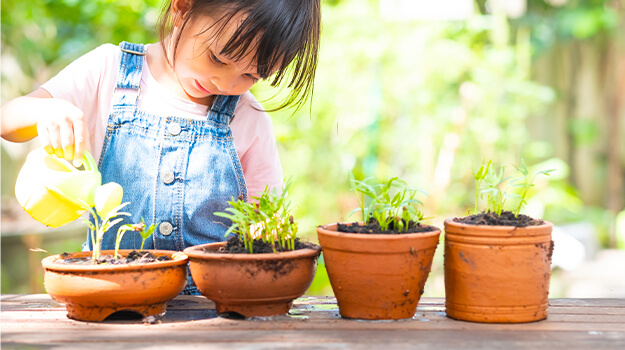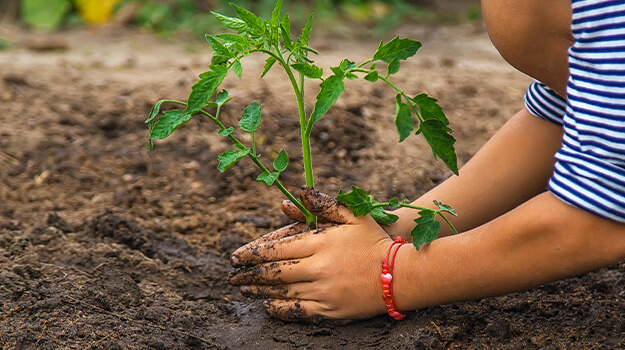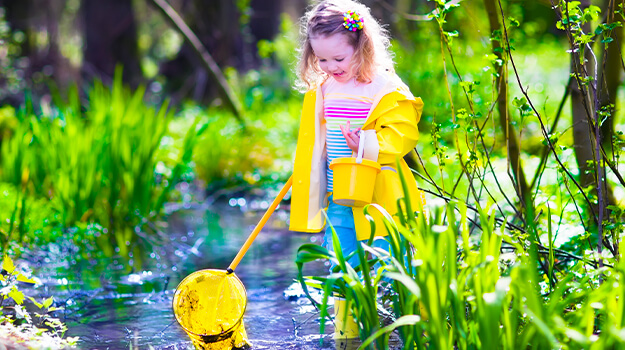Today's gardeners are some of the first to have to deal with the climate crisis.
Designing, plant selection, planting and maintenance methods: everything needs to be rethought. To survive the vagaries of the weather, tomorrow's garden will feature more plants capable of weathering heat waves and enduring prolonged periods of drought.
Some plants curl up during extreme heat to limit evaporation. While they are temporarily less attractive, they at least can grow again instead of wilting, offering an impressive and, above all, unconditional spectacle.
Perhaps we'll have to get used to the fact that not everything is perfect... and learn to appreciate the garden at its peak.
What will the gardens of tomorrow look like?
France, 2019. After an extraordinary series of heatwaves, forsythias, privets and hydrangeas, shrubs long cultivated throughout the country, lost their leaves in July. Pansies and geraniums, two plants long cultivated in every garden, have since been gradually replaced by Mediterranean plants that are more resistant to heat and drought.
Research is now underway in France to identify 52 plants capable of surviving in their overheated climate. Within fifty years, rising temperatures are predicted to make growing many plants impossible, even native species. To avoid being caught off guard, efforts are underway to define the plants that will make up the gardens of tomorrow.
In America, too, there are clear signs that landscapes will have no choice but to adapt to climate change.
How to adapt your garden to global warming
A garden adapted to climate change promotes biodiversity and water retention. It is made up of plants resistant to drought and extreme temperatures. The plantings are dense, have many shaded areas and the soil is rich in organic matter.
Considering this, most gardens can be modified to make them more resilient. No drastic changes are required. For many of us, the transition is already underway, and every time we choose a plant well adapted to our yard or implement processes that allow us to water less or more effectively, we continue to evolve our current outdoor space into that of tomorrow.
3 simple ways to make your garden more resilient
Choosing plants adapted to your local conditions, elevating water management, improving soil quality and creating a favourable microclimate are all ways to create a resilient garden.
Choosing the right plants for the right location
Drought-tolerant plants
Mediterranean plants, succulents, perennials and shrubs with small, glossy leaves... Some plants tolerate heat well and survive periods of drought beautifully. Check out our list. Also discover Mediterranean-style gardens.
Native plants
Native species are often better adapted to the climatic conditions and pests in your region. Find out more... They are more numerous and more spectacular than you might think!
Plants adapted to temperature variations
Choose plants that can withstand both heat and cold. Alpine plants can be a good option, depending on the region you live in.
NOTE: Don't always plant the same plants. Diversifying species improves your garden's resilience to climatic hazards while contributing to biodiversity and ecosystem protection.
Effective water management
For years, gardeners have evolved the best watering methods. So much so that they may have forgotten how precious water is. Newer methods tend to remind gardeners of this and bring us back to new ways of doing things. In French, there is an old saying that goes “one hoeing is worth two waterings”, reminding us that hoed soil retains water better. It’s high time we put it into practice!
Discover our list of mineral garden (or dry garden) plants that don't require watering.
Ecological irrigation systems
Do you want to keep certain ornamental or vegetable plants that require frequent watering? Consider drip irrigation systems, which are efficient and avoid waste.
The use of ollas is another great option! These are unglazed terracotta pots that are partially submerged in the ground. The water poured into them will be released according to the soil's needs. They come in different shapes and sizes to suit flower beds, vegetable gardens and pots. They provide targeted hydration and are extremely practical if you must be away for a few days!
Rainwater harvesting
Rainwater barrels can significantly reduce the use of good drinking water!
Permeable driveways and soils
During a downpour, hard surfaces can sometimes direct water in areas that create problems, such as basements. If you can, choose permeable surfaces over concrete or asphalt. Also consider creating raised planting areas (like alpine gardens) that promote infiltration, or a runoff water retention basin. Like rain gardens, these can be done on a small scale on a plot of land with sufficient space!
Mulching
From the moment it's applied, mulch helps maintain soil moisture and reduce water evaporation.
Also read: 10 Tips for gardening in a heatwave
Improve soil quality
Quality potting soil
Whenever you plant, use a potting soil rich in organic matter like our PRO-MIX Vegetable & Herb Mix or our Premium All Purpose Mix. They contain peat moss, perlite, coir or other ingredients that promote better water absorption.
Compost
Compost enriches the soil with organic matter, improving its structure and water retention capacity. If you make your own compost, consult our Composting Guide to get the most out of it.
Mulch
As it decomposes, mulch enriches the soil while improving its structure and water retention capacity.
Crop rotation
When growing vegetables, avoid planting in the same spot two years in a row. Discover the benefits of crop rotation in our article.
Create a favourable microclimate
Use trees and shrubs, either as hedges or on their own, to create shaded, wind-protected areas that will protect plants that cannot tolerate direct sunlight and drying winds. Trellises, fences and pergolas can also play the same role. They provide structures on which to grow climbing plants.
Integrate wetlands
Ponds can help regulate the microclimate while promoting biodiversity in the garden. If you're limited in space, consider fountains, birdbaths and bee waterers, which help animal and plant species while providing a breath of fresh air.
Build strips covered with vegetation
A vegetated strip is a space reserved for native plants and wildflowers that support local beneficial insect populations. For information on what to plant, see our article. (Attract beneficial insects to the garden)
Focus on eco-friendly solutions to combat pests
Whenever you can, choose natural solutions and biopesticides over chemicals. They are effective and safe for wildlife, plants and groundwater.
Here are some types of gardens and their benefits in terms of climate resilience:
- Dry garden: Also called “mineral garden”, this type of landscaping favours the use of mineral materials and plants that are highly tolerant to heat and drought. Learn more here.
- Xeriscape: Xeriscaping is a landscaping technique developed to address climate change by focusing primarily on water conservation. More information here.
- Mediterranean garden: Offering a beautiful variety of colours and fragrances, this type of garden features plants that tolerate drought and elevated temperatures admirably.
- Edible plant garden: To be resilient and self-sufficient, this type of garden incorporates fruit trees, small fruit shrubs and perennial vegetables (artichokes, rhubarb, Jerusalem artichokes). Once established, they require less water.
- Rain garden: This well-designed garden offers a variety of ways to cope with climate change and extreme temperatures. It facilitates the transport of water during torrential rains, collects it and filters it, making it available to plants to minimize watering.
- Alpine garden: This type of raised rock garden with different levels helps better manage rainwater runoff and creates microclimates favourable to biodiversity. Discover the alpine garden here.
Also read: How to create a drought-resistant xeriscape

